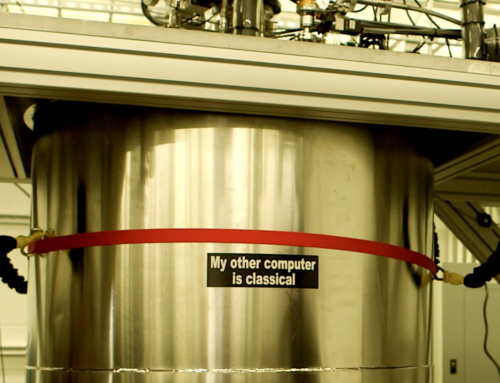Feature image: IBM’s System One quantum computer, via The New York Times.
Words are important. The language we use to describe something creates a discourse around it, endowing it with a life of its own and often producing meaning beyond the definition of the words themselves. Like many expressions in the emerging technology space (think: disruptive innovation, IoT or even artificial intelligence) the expression ‘quantum supremacy’ has been over-used and misused to a point where the original relevance of the term has been buried under a mountain of hype. Has this expression been transformed into an empty buzzword through this process—like a game of ‘telephone’, its meaning distorted along the way? Now, with Google’s proclamation of achieving quantum supremacy officially published, criticism has been flooding in; not only with regard to the claim itself but more fundamentally, of the usefulness of ‘supremacy’ as a benchmark at all.
Just last week IBM, one of Google’s main competitors in the quantum space, posted a critique of Google’s shrouded announcement on their blog. The article, penned by Edwin Pednault, John Gunels and Jay Gambetta—leaders and members of IBM’s quantum research and development team—urges that Google’s achievement should not be misconstrued ‘as proof that quantum computers are ‘supreme’ over classical computers.’ The team takes issue with the way in which ‘quantum supremacy’ has come to imply that quantum computers will one day reign ‘supreme’, replacing classical computers. They assert that the future of quantum computing will be intertwined with classical computing, the two uniquely-suited systems will work in concert with one another.
IBM’s statement adds further complexity to the situation, citing that Google may not have even achieved quantum supremacy at all, according to John Preskill’s original definition of the term, ‘to describe the point where quantum computers can do things that classical computers can’t, regardless of whether those tasks are useful.’ The point of contention: Google has stated that their Sycamore processor was able to compute the answer to a specific problem in about 200 seconds, a task they claim would take 10,000 years to compute on the world’s most powerful supercomputer. IBM argues, however, that the comparison does not account for any of the unique capabilities of classical computing, which if properly leveraged, could bring that number down to just 2.5 days. While that’s a significant difference in estimation between Google and IBM, worthy of headlines itself, it should be noted that neither team has actually tested the calculation on a supercomputer yet.
Whether or not the disparity in time to compute between quantum and classical is measured in days or years, the fact remains that what Google demonstrated on their quantum processor can also be done on a classical computer, albeit much more slowly. Still, as Preskill commented in a recent interview for Quanta Magazine on the subject, Google’s achievement is significant in that it demonstrates the team understands the hardware they have built and that it is working. When stripped of the hype associated with the terminology, this may seem a far more lacklustre news item. Nonetheless, it is an important step forward in the development of useful quantum computing applications, which is where the real fruits of the industry’s labour will finally be tasted, across areas as diverse as healthcare, hacking, and honing.
As Project Q and others have explained in coverage of Google’s announcement, the terminology used can be misleading at best and simply a product of the media hype machine at worst. But hype has its value too. Hype can insulate against the arrival of a quantum winter—a scenario where interest and investment in quantum technologies drop off due to the technology’s failure to deliver on its promise. There is concern that a quantum winter could mean the technology never reaches the immense promise of its applications. However, private funds continue to flood the industry. According to research by Nature, ‘in 2017 and 2018, companies received at least $450 million in private funding—more than four times the $104 million disclosed over the previous two years.’ While hype contributes to potentially overstating the promise of quantum computing in the first place, it also plays a critical role in pushing the development of quantum computing forward by keeping the buzz and enthusiasm high.
It’s important to recognize the role of hype in technological progress. It is also important, however, to have access to a more nuanced understanding of the progress of quantum development, to dive deeper than the terminology and the hype around it. Without a doubt, the terminology used to dictate a turning point in the development of quantum computing is problematic, even according to its creator. This was also IBM’s central point in their argument: ‘we urge the community to treat claims that, for the first time, a quantum computer did something that a classical computer cannot with a large dose of scepticism due to the complicated nature of benchmarking an appropriate metric.’ Quantum supremacy, while a significant step in quantum’s development, is by definition an incredibly narrow benchmark with practically no real-world utility. However, it has value in its ability to capture the imagination of society and keep people engaged in the progress of one of tomorrow’s most promising technologies.







[…] establishing a concept that is easily consumable for the masses, which helps to create the hype that keeps funding for that application flowing. The reality, as is often the case, is much more […]